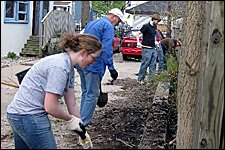June 16, 2011 | WMU News

Dr. Kim Cummings, professor emeritus of sociology at Kalamazoo College, has brought the class to WMU as an adjunct professor. Working in collaboration with the Building Blocks program, which he helped start, students in his class--Special Studies in Social Welfare Practice: Community Organizing II--go into low-income neighborhoods and, with the guidance of supervisors selected by neighborhood associations, canvass their two- to three-block site to recruit interested residents. They assist residents in planning and implementing small-scale home fix-up and improvement projects. Grant money pays for supplies, but residents do the work, gaining trust in each other and the capacity to continue working together over time to improve their street.
Building Blocks of Kalamazoo is entering its 17th year of operation and has organized residents in more than 120 sites in the Eastside, Edison, Fairmont, Northside, Oakwood, Stuart and Vine neighborhoods. During that time, 327 student organizers have helped improve neighborhoods while learning skills that will serve them in public and private life.
Until this year, Cummings operated the program and class in collaboration with Kalamazoo College. They now are being offered in partnership with the WMU School of Social Work.
"The students were eager to continue such a course, the neighborhoods' loyalty to the program was clear and the city was eager to keep it going as well," Cummings says. "With the help of several key individuals, I managed to connect with the School of Social Work at WMU and they were very eager to make it part of their program."
The class and program offer an intense learning experience in which students act as neighborhood coordinators and develop advanced organizing skills. When Building Blocks was started in spring 1995, Cummings was looking for a way his students could gain those skills and was sure students could handle the responsibility of working with residents to tackle projects residents deemed important to their communities. Building Blocks started as a pilot program and expanded as it won support from neighborhood associations.
This summer, students are working in the Eastside, Fairmont, Vine and Oakwood neighborhoods. The Building Blocks program also is conducting projects without student help in the Stuart and Edison neighborhoods.
"Ultimately, residents on a given street, their quality of life and the viability of that neighborhood depend on being organized, because problems keep cropping up that cannot be dealt with by individuals in isolation," Cummings says. "If people want to stay abreast of their problems, there's simply no alternative for them but to be organized."
Neighborhood associations recognize that, but lack the personnel to reach out to all of their residents. Building Blocks, using student help, allows the associations to extend their efforts, connect with residents and pull them together.
Students organize residents, who identify projects to improve their homes, the collective impact of which improves the appearance and value of whole streets. Projects take place on weekends and range anywhere from grading gravel driveways to scraping and painting a house. In the process, residents emerge from the isolation dividing them, band together and learn to defend their neighborhood.
"Our mission is to build a community one block or one street at a time," Cummings says.
It's been very beneficial having the students and the program working in their neighborhoods, the associations agree.
"I've been a neighborhood director for a long time and Building Blocks is one of the most important things we do," says Cheryl Lord, of the Oakwood Neighborhood Association. "It's a grassroots organization, and working with Building Blocks is one of the first times people get to know who their neighbors are and we get to know who they are and what their needs are."
Lord says half of her board of directors got involved with her association through the program.
"It's a wonderful way to network. People meet their neighbors and work side by side with them and get to know them. It's a wonderful experience. I don't know what we would do without it and I'm so pleased Western took this on."
The program and class will provide a great learning opportunity for WMU students, says Dr. Linwood Cousins, director of the School of Social Work.
"The School of Social Work is excited to offer Building Blocks with a focus on neighborhood and community development, hidden gems in the training and practice of professional social work," Cousins says. "President Barack Obama, although not a graduate of a social work program, participated in this rich tradition of social work community and neighborhood organizing through his work in Chicago and the history of these activities there. We are happy that professor Cummings is extending an important opportunity alongside the work of professor Don Cooney and others to train students and at the same time to serve neighborhoods and communities in Kalamazoo and Southwest Michigan."
For more information, call Kim Cummings at (269) 342-6943.